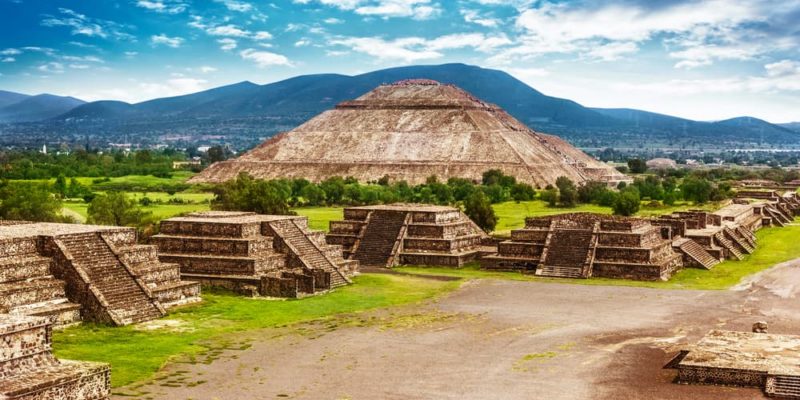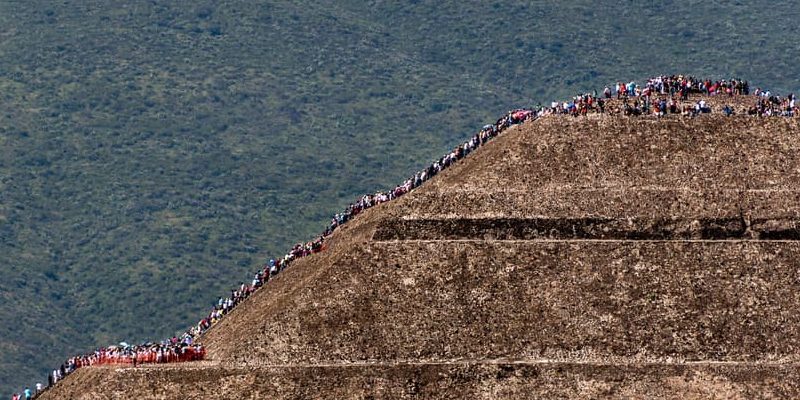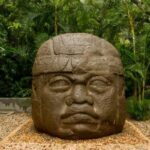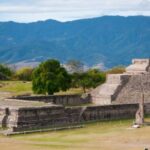We explain everything about the Teotihuacan culture. Location, economy, religion and other characteristics. Furthermore, its main contributions.

What was the Teotihuacan culture?
We speak of Teotihuacan culture or Teotihuacán culture to refer to the original inhabitants of the ancient city of Teotihuacán one of the largest urban centers in pre-Hispanic Mesoamerica. This city was founded around 100 BC. c.
Little is known about the ethnic character of this Mesoamerican culture, although some research suggests that It could have been a multicultural center with inhabitants from various ethnic groups.
Many aspects of the Teotihuacan culture are still unknown, and its origins and disappearance are the subject of debate among specialists. Its existence is known mainly from the ruins of its city, Teotihuacán, one of the largest urban centers in the world in its heyday.
The extensive influence of this culture is observed in the Teotihuacan motifs found in the ruins of other Mesoamerican ceremonial centers, such as Tikal or Chichen Itzá. Even After the fall and abandonment of Teotihuacán, this city was a pilgrimage center for other Mesoamerican cultures like the Mexica or Aztecs, who attributed religious importance to it.
Since it is unknown what the Teotihuacans called themselves, The name given to them today comes from Nahuatl the language of the Mexica, and means “place of the gods.”
The city of Teotihuacan It was destroyed in the 7th century AD. C. and later abandoned possibly due to a combination of climatic and political factors. Today it is an important area of archaeological monuments, with high tourist and historical interest, and is famous for its great pyramids.
Other Mesoamerican cultures were: Aztec culture, Toltec culture, Mayan culture, Olmec culture, Totonac culture, Zapotec culture, Mixtec culture.
Key points
- The Teotihuacan culture emerged in the city of Teotihuacán, in the Valley of Mexico, around 100 BC. c.
- It was noted for its intensive agriculture, its commercial links and its monumental architecture, such as the pyramids of the Sun and the Moon.
- The city of Teotihuacán was one of the largest in the world in its time of splendor, between the 2nd and 7th centuries AD. c.
- Its decline occurred in the 7th century AD. C. with the destruction and abandonment of the city, although the exact reasons for this event are unknown.
See also: Mesoamerican cultures
Geographic location of the Teotihuacan culture

The city of Teotihuacan It was located in the northeast of the Valley of Mexico, in the current state of Mexico between the municipalities of Teotihuacán and San Martín de las Pirámides, about 50 kilometers away from Mexico City. This area was declared a world heritage site by UNESCO in 1987.
The city of Teotihuacán occupied around 20 square kilometers and The Teotihuacan culture spread around the city. Its influence also reached the Gulf of Mexico and areas of the west and north.
Its heyday took place during the Classic period, between the 2nd and 7th centuries AD. C., when its decline occurred, possibly due to a combination of political instability and climate change.
Characteristics of the Teotihuacan culture

Judging by the remains of Teotihuacán, its founders were expert builders who specialized in architecture monumental. His pyramids of the Sun and the Moon, his temple to Quetzalcóatl and other similar buildings are famous, whose walls were painted with allegorical motifs related to his religion and his worldview. Also Their fine ritual pottery and masks stood out and other stone or terracotta artifacts.
The surroundings of the city were used for agricultural development and the exploitation of resources such as obsidian. Thanks to this, Teotihuacán It became an important commercial center that maintained exchange relations with other Mesoamerican societies. The Teotihuacan culture had a strong cultural influence in other regions but it also expanded politically and conquered other neighboring cities, including some in the Mayan area.
It is likely that, like other Mesoamerican cultures, Teotihuacan society was made up of priests, warriors, merchants and farmers.
Religion and gods of the Teotihuacan culture

The Teotihuacans had a complex, polytheistic religion which had many points of contact with the religions of other Mesoamerican cultures, both previous and contemporary as well as later, surely through dynamics of inheritance and cultural influence.
For example, the cult of the feathered serpent, Quetzalcoatl, was common in other cultures of the region. In Teotihuacan, Quetzalcoatl was venerated in an impressive temple in addition to being present in the form of statuettes and represented in murals.
Other important gods of the Teotihuacan pantheon were Tláloc, god of rain; Huehuetéotl, god of fire; Tezcatlipoca, god of heaven and earth; Chalchiuhtlicue, goddess of water. They also had a set of mythical or sacred animals, such as the owl, the puma, the eagle and the snake.
It is very likely that their rites involved human sacrifices common practice in the region. The sacrifices were carried out by an elite of priests or shamans.
The city of Teotihuacan

Teotihuacán was the main city of the Teotihuacan culture and the only one that survived in the archaeological record to the present day. The name Teotihuacán given by scholars to this culture comes from the name in the Nahuatl language that the Mexica or Aztecs gave to the city (which translates as “place of the gods”).
The history of this city was not only an object of interest and curiosity for modern historians, because at the time The Toltecs and Mexica made their ruins a pilgrimage site. Currently, Teotihuacán is, along with Chichén Itzá, El Tajín and Monte Albán, one of the places of greatest tourist and archaeological interest in the Mesoamerican region.
At its peak, Teotihuacán covered an area of around 20 square kilometers making it one of the largest cities in the world. It is estimated that it housed a population of between 100,000 and 200,000 inhabitants. It included homes, craft workshops and a ceremonial center.
Famous are its Causeway of the Dead, on a north-south axis, crossed at the time by the San Juan River, which was diverted from its channel by the Teotihuacans themselves; the pyramids of the Sun and the Moon; the Mythological Animals building; the palace of Quetzalpapálotl; the citadel; the temple of Quetzalcoatl; and the housing complexes of Yayahuala, Tetitla, Xalla and Zacuala.
The city of Teotihuacán was destroyed in the 7th century AD. C. and later abandoned without the reasons being known, although it is believed that it was due to climate changes and political conflicts.
Teotihuacan economy
The Teotihuacan economy, like that of many other Mesoamerican cultures, was based on three axes:
- Agriculture. Corn, beans, chiles (peppers) and pumpkins were especially grown, all using irrigation techniques and chinampas (raised fields in lake or swampy areas).
- Trade. It was facilitated by the enormous dimensions of the city and its important influence in the region. In the workshops of Teotihuacán, artisanal goods were manufactured that were used internally for practical or ceremonial purposes, and were exchanged for goods from other cultures thanks to the presence of merchants.
- Tribute. Teotihuacan warriors forced neighboring towns or cities to pay tribute through conquest or military threat, as is believed to have also happened with the Mayan city of Tikal, much further away.
Contributions of Teotihuacan culture

Although not much is known about the original inhabitants of Teotihuacán, their legacy was felt in the region. The Teotihuacan culture influenced many contemporary and later cultures, and today the ruins of what was its great metropolis persist, which were studied by archaeologists and in some cases restored. Today, it is a tourist site that attracts more than two million visitors each year.
Part of their mythological stories are also preserved. Many of their beliefs were shared totally or partially with other Mesoamerican cultures, and also some societies, such as The Mexica included Teotihuacán in their own myths, as they considered it the place of origin of the gods.
Also its ceramics and masonry, its impressive monumental architecture and engineering endure and their colorful ceremonial masks, with which they performed their religious rites.
References
- Britannica, Encyclopaedia (2024). Teotihuacan. Encyclopedia Britannica. https://www.britannica.com/
- López Austin, A. & López Luján, L. (2001). The indigenous past. Economic Culture Fund-El Colegio de México.
- Manzanilla, L. & López Luján, L. (coords.) (2001). Ancient History of Mexico. 4 vols. National Institute of Anthropology and History.
- von Wobeser, G. (ed.) (2014). History of Mexico. Economic Culture Fund.





